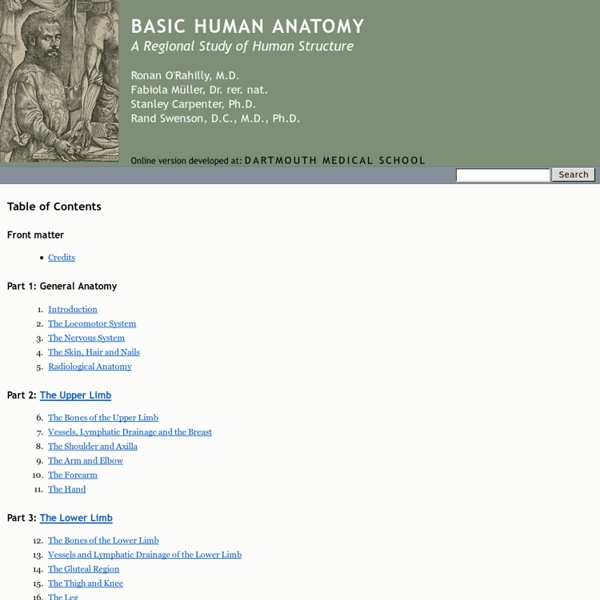



http://www.dartmouth.edu/~humananatomy/index.html
Brain Atlas - Introduction The central nervous system (CNS) consists of the brain and the spinal cord, immersed in the cerebrospinal fluid (CSF). Weighing about 3 pounds (1.4 kilograms), the brain consists of three main structures: the cerebrum, the cerebellum and the brainstem. Cerebrum - divided into two hemispheres (left and right), each consists of four lobes (frontal, parietal, occipital and temporal). The outer layer of the brain is known as the cerebral cortex or the ‘grey matter’. It covers the nuclei deep within the cerebral hemisphere e.g. the basal ganglia; the structure called the thalamus, and the ‘white matter’, which consists mostly of myelinated axons.
Student Nurse - A&P Anatomy and Sectional Terminology It sounds silly, but you learn as many new words in an A&P course as you do a beginning foreign language course. Really --there's been research to prove it! - Kevin Patton Links here are for general A & P resources. The 50 Best Freelance Tools for Freelancing Online Ah, the life of self-employment. It is certainly a rewarding one, but remember, it’s a jungle out there. Here at Bidsketch, we feel your pain: the internet offers such a vast ocean of resources that it can be hard to tell which ones are actually worth using. I’d like to believe that this post will alleviate a huge part of that burden. While it took many hours to write, edit, and re-write, it took countless hours of me procrastinating from my work and trying out new tools!
Anatomy and Physiology animations Listed below are a collection of physiology animations and anatomy animations. These animations are intended to support text or lecture and it is important that they are not seen as stand-alone reference material. Notes: If you or your students discover any factual errors in the animations please let me know: andrew@visualization.org.uk Some of the animations can only be accessed from the university network - please contact Liz Hodgson in the LDU if you would like them on WebCT so that students can access them externally. Visual detail in Flash animations can often be magnified (click on the animation with the right mouse button and use the zoom control) Here are some animations of organs/organ systems: Cranial nerves (No text version)
Curriculum Is More Important Than Learning Technology Curriculum Is More Important Than Learning Technology by Grant Wiggins, Ph.D, Authentic Education Here’s a stunner from the weekend New York Times, in a front-page article, no less: “schools are spending billions on technology, even as they lay off teachers, with little proof that this approach is improving basic learning.” I’m shocked, shocked! Who in their right mind thinks that spending $5000 per classroom on a whiteboard is going to improve student achievement?
Anatomy and Physiology Learning Modules - CEHD - U of M Quiz Bowl and Timed Test were retired at the end of summer 2013. Quiz Bowl had always been buggy, as many people had pointed out, and it had become difficult to maintain. It also used technology that doesn’t work on a lot of newer computers or tablets. Timed test depended on a browser add-on that both Microsoft and Apple have encouraged users to remove for security concerns. For these reasons, we took these two quizzes down at the end of the month. Thanks to everyone who has shown support for them, and we hope you continue to use the other quizzes on this site! 5 Common Uses Of Technology In The Classroom & How We Screw Them Up Using technology to enhance learning is an incredibly exciting idea, and as an area of education is growing fast. Blended learning, mobile learning, connectivism, and other increasingly popular ideas all owe their existence to technology. But the reality in the majority of public schools in the United States is less than cutting edge. While there is little data available to pinpoint exactly what is being done where, five of the more common applications of technology in the classroom appear below.
Anatomy Videos <span>To use the sharing features on this page, please enable JavaScript.</span> These animated videos show the anatomy of body parts and organ systems and how diseases and conditions affect them. The videos play in QuickTime format. What Is Competency-Based Learning? What Is Competency-Based Learning? by TeachThought Staff Competency-based learning is an approach to education that focuses on the student’s demonstration of desired learning outcomes as central to the learning process.